by Bruce Wells | Jan 22, 2024 | This Week in Petroleum History
January 22, 1861 – Pennsylvania Refinery produces Kerosene –
The first U.S. multiple-still refinery was brought on-stream one mile south of Titusville, Pennsylvania, by William Barnsdall, who had drilled the second successful well after Edwin Drake’s first U.S. oil discovery.
Barnsdall and partners James Parker and W.H. Abbott spent about $15,000 to build six basic stills for refining kerosene. Much of the equipment was purchased in Pittsburgh and shipped up the Allegheny River to Oil City. The refinery produced two grades of kerosene, white and the less the expensive yellow.
January 22, 1910 – Standard Oil of California strikes Oil
Standard Oil Company of California (Socal) drilled its first successful oil well, a gusher in Kern County that initially produced 1,500 barrels of oil a day from the Midway-Sunset field, The discovery came after the 1906 merger of Pacific Coast Oil Company (see First California Oil Well) and Standard Oil Company of Iowa to create Socal.
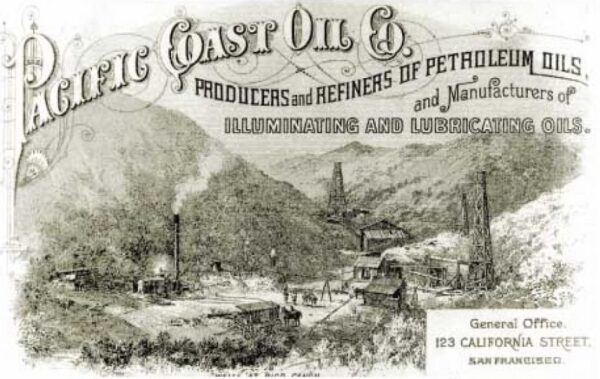
Standard Oil Company of California (Socal) began in 1879 as the Pacific Coast Oil Company, and in 1981 renamed Chevron. Image courtesy Chevron.
The new company needed more oil reserves after it had “stepped up its marketing efforts, particularly in gasoline sales, which nearly doubled between 1906 and 1910,” according to a company history. “Until now, Standard had left the hunt for oil to others.”
The U.S. Supreme Court in 1911 ordered Socal separated from its parent, Standard Oil Company of New Jersey. After absorbing Standard Oil of Kansas in 1961 and making other acquisitions, the California company in 1984 rebranded as Chevron, headquartered in San Ramon.

January 23, 1895 – Standard Oil closes Oil Exchanges
Standard Oil Company of New Jersey’s purchasing agency in Oil City, Pennsylvania, notified independent oil producers it would only buy their oil at a price “as high as the markets of the world will justify” — and not “the price bid on the oil exchange for certificate oil.”
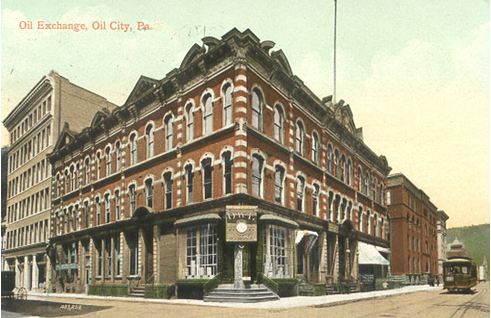
The Oil City, Pennsylvania, Oil Exchange incorporated in 1874. By 1877, it was the third largest financial exchange in the United States.
Oil City’s exchange had become the third largest financial exchange of any kind in America, behind New York and San Francisco. But with the Standard Oil Company buying 90 percent of oil production and setting its own price for certificates, all other oil exchanges soon closed.
Learn more in End of Oil Exchanges.
January 23, 1957 – Wham-O launches a New Petroleum Product
One of the earliest mass-produced products made from plastic, the “Frisbee” was introduced by Wham-O Manufacturing Company of California. The toy originated in 1948 when a company called Partners in Plastic sold its “Flyin’ Saucers” for 25 cents each. In 1955, Richard Knerr and Arthur “Spud” Melin’s Wham-O bought the rights.
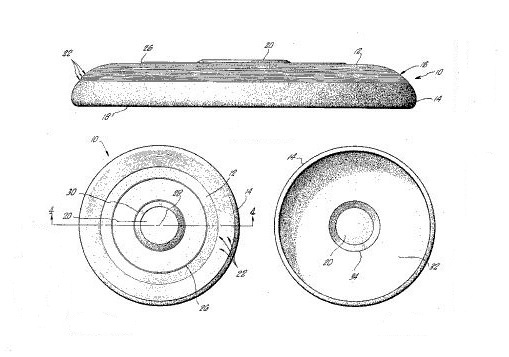
U.S. patent detail of a 1967 polyethylene plastic Frisbee.
The Wham-O founders discovered that Phillips Petroleum had invented a high-density polyethylene (called Marlex). They used the new plastic to meet phenomenal demand for manufacturing Frisbees – and Hula Hoops beginning in 1958.
Learn more in Petroleum Product Hoopla.

January 23, 1991 – Gulf War brings World’s Largest Oil Spill
The world’s largest oil spill began in the Persian Gulf when Saddam Hussein’s retreating Iraqi forces opened pipeline valves at oil terminals in Kuwait. About 11 million barrels of oil would cover an area extending 101 miles by 42 miles and reaching five inches thick in some places.
Iraqi soldiers sabotaged Kuwait’s main supertanker loading pier, dumping millions of gallons of oil into the Persian Gulf. By February, about 600 Kuwaiti wells had been set ablaze. It would take months to put out the well fires, with the last extinguished in early April 1991.
January 24, 1895 – Pure Oil Company founded by Independent Producers –
To counter Standard Oil Company’s market dominance, Pennsylvania oil producers, refiners, and pipeline operators organized what would become a major Chicago-based oil venture. Originally based in Pittsburgh, Pure Oil Company quickly grew into the second vertically integrated U.S. petroleum company after Standard Oil.
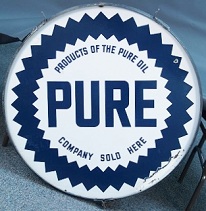
An Ohio firm adopted the old Pennsylvania name.
Beginning in early 1896, Pure Oil marketed its petroleum products by horse-drawn tank wagons in Philadelphia and New York — successfully competing with Standard Oil’s monopoly. The Ohio Cities Gas Company of Columbus acquired Pure Oil and in 1920 adopted the former Pennsylvania venture’s brand name.
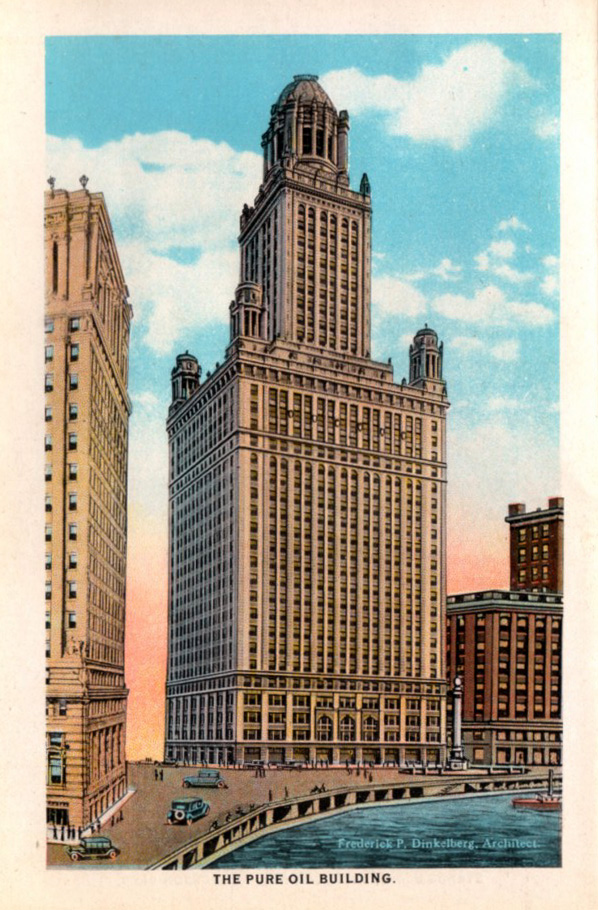
Pure Oil Company in 1926 moved into its new 40-story Chicago headquarters building at 35 East Wacker Drive.
With a new Chicago headquarters opened in 1926, Pure Oil began exploring offshore technologies within a decade. The company developed early freestanding drilling platforms in the Gulf of Mexico.

January 25, 1930 – North Texas Oil Producers form Association
After meeting in Wichita Falls to protest “the recent drastic price cut in crude oil, inaugurated by some of the major purchasing companies,” 50 independent producers organized the North Texas Oil and Gas Association. Other issues included seeking a tariff on foreign oil imports and stopping “hot oil” oilfield thefts. The association merged with the West Central Texas Oil & Gas Association in 1998 to become the Texas Alliance of Energy Producers.
January 26, 1931 – Third Well reveals Extent of East Texas Oilfield
As East Texas farmers struggled to survive the Great Depression, an oil discovery confirmed the existence of a massive oilfield. W.A. “Monty” Moncrief of Fort Worth completed the Lathrop No. 1 well, which produced 7,680 barrels of oil a day from 3,587 feet deep. Geologists at first thought a third oilfield had been found.
Moncrief’s discovery well was 25 miles north of the famous Daisy Bradford No. 3 well of October 1930, drilled by Columbus Marion “Dad” Joiner. It was 15 miles north of the Lou Della Crim No. 1 well, completed at Kilgore three days after Christmas 1930. The 130,000-acre East Texas oilfield would become the largest in the lower-48 states.
Learn more in Moncrief makes East Texas History.
January 28, 1921 – “Vaseline Well” erupts in Oklahoma
After reaching a depth of 3,710 feet, drillers of the W.C. Newman well near Lamar, Oklahoma, “hit into a strata of oil, the like of which never before, nor since has been found,” reported the Daily Oklahoman in a 1933 retrospective of the well, which “caused oil men to marvel then, as today, since it produces the same Vaseline-like content.”
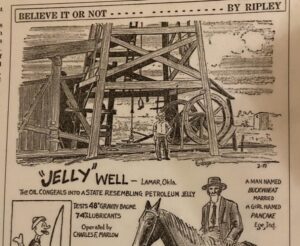
High-viscosity oil from the 1921 Oklahoma well was featured by the syndicated Believe It or Not by Ripley. Illustration courtesy Hughes County Historical Society Facebook Page.
The Hughes County well erupted a dark green oil that “turned into a brilliant yellow when it came into contact with the outside air” and sprayed 200 feet of a semi-solid mass that “hung like gum from the nearby fences, trees and other structures,” noted the newspaper.
“Ordinary pipelines would not carry the oil, so a special line, sandwiched between four steam pipes to heat the almost solid lubricant enabled it to flow to storage tanks,” the article added. Featured as the “jelly” well in the syndicated Believe it or Not by Ripley, by 1933 daily production of 350 barrels of the high-viscosity oil had declined to 15 barrels.
January 28, 1969 – Oil Spill at Santa Barbara, California
After drilling 3,500 feet below the Pacific Ocean floor, a Union Oil Company drilling platform six miles off Santa Barbara suffered a blowout. The accident spilled an estimated 100,000 barrels of oil into the ocean with some reaching southern California’s beaches, including Summerland — where early U.S. offshore petroleum history began in 1896 with wells drilled from piers.
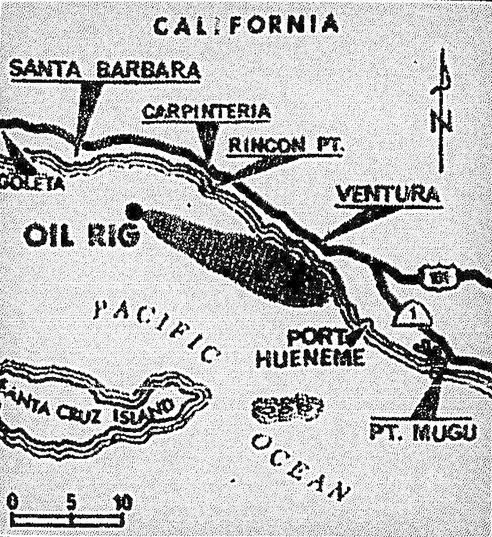
Beyond the 1969 Santa Barbara spill, marine scientists have noted California’s natural oil seeps continue to leak tons of petroleum every day.
The drilling crew had begun to retrieve pipe in order to replace a drill bit when the mud used to maintain pressure became dangerously low, causing a natural gas blowout, according to the University of California, Santa Barbara. The well, which was brought under control after 12 days, turned public opinion against offshore exploration and helped lead to creation of the Environmental Protection Agency (EPA) in December 1970.
Naturally occurring oil seeps in the Santa Barbara Channel have been significantly reduced by offshore oil production, according to “History of Oil in the Santa Barbara Channel,” a 2018 exhibit at the Santa Barbara Maritime Museum.
Learn more in Oil Seeps and the Santa Barbara Spill.
January 28, 1991 – Parker Rig No. 114 becomes Tourist Attraction
Among the biggest drilling rigs in the world, Parker Drilling Company’s Rig No. 114, was erected in a vacant lot in downtown Elk City, Oklahoma, after civic leaders realized that the massive rig, visible from I-40 and historic Route 66, could draw tourists. The Parker rig had once drilled deep wells for testing nuclear bombs.

Parker Rig No. 114 has welcomed visitors to Elk City, Oklahoma, since 1991. Photo by Bruce Wells.
In 1969, Parker Drilling signed a contract with the U.S. Atomic Energy Commission to drill a series of holes up to 120 inches in diameter and 6,500 feet deep in Alaska and Nevada. After the experiments, the company modified its rig to drill conventional wells that set records by reaching beyond four miles deep into the Anadarko Basin.
The 17-story Parker No. 114 today stands in downtown Elk City next to the former Casa Grande Hotel at the intersection of 3rd Street and Route 66. Casa Grande, which opened in 1928 to lodge the highway’s travelers, was added to the National Register of Historic Places in 1995. It also was once home to a natural history museum that included petroleum exhibits.
_______________________
Recommended Reading: Titan: The Life of John D. Rockefeller, Sr. (2004); Plastic: The Making of a Synthetic Century
(2004); Plastic: The Making of a Synthetic Century (1996); Against the Fires of Hell: The Environmental Disaster of the Gulf War
(1996); Against the Fires of Hell: The Environmental Disaster of the Gulf War (1992); The Black Giant: A History of the East Texas Oil Field and Oil Industry Skulduggery & Trivia
(1992); The Black Giant: A History of the East Texas Oil Field and Oil Industry Skulduggery & Trivia (2003); Slick Policy: Environmental and Science Policy in the Aftermath of the Santa Barbara Oil Spill (2018);. Your Amazon purchase benefits the American Oil & Gas Historical Society. As an Amazon Associate, AOGHS earns a commission from qualifying purchases.
(2003); Slick Policy: Environmental and Science Policy in the Aftermath of the Santa Barbara Oil Spill (2018);. Your Amazon purchase benefits the American Oil & Gas Historical Society. As an Amazon Associate, AOGHS earns a commission from qualifying purchases.
_______________________
The American Oil & Gas Historical Society (AOGHS) preserves U.S. petroleum history. Become an AOGHS annual supporting member and help maintain this energy education website and expand historical research. For more information, contact bawells@aoghs.org. Copyright © 2024 Bruce A. Wells. All rights reserved.
by Bruce Wells | Dec 21, 2023 | Petroleum Technology
The petroleum industry’s difficult job of retrieving broken (and expensive) equipment obstructing an oil well — “fishing” — began in 1859, when a drilling tool stuck at 134 feet deep and ruined a Pennsylvania well. The technical challenges at far greater depths have tormented exploration companies ever since.
Just four days after the August 27, 1859, first U.S. oil discovery by Edwin L. Drake at Titusville, Pennsylvania, a much less known oil and natural gas industry pioneer began America’s second well to be drilled for petroleum. John Livingston Grandin dug his well nearby using a simple spring pole — but soon wedged his iron chisel downhole.
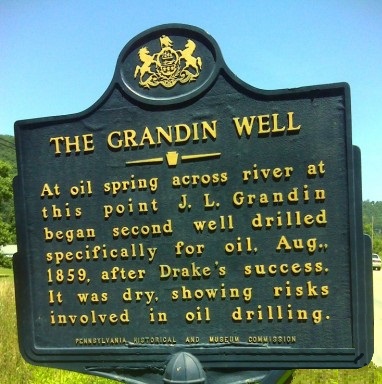
John L. Grandin attempted to recover a lost drill bit at his 1859 well near Tidioute, Pennsylvania. Warren County roadside marker photo.
The 22-year-old Grandin improvised his own well fishing tools, but not only lost his drill bit (an industry first), he ended up with America’s first dry hole among other petroleum industry milestones.

Searching for oil was less an earth science and more an art in the exploration and production industry’s earliest days. Geologists in Pennsylvania’s “valley that changed the world” knew far more about finding coal seams than characteristics of oil-bearing formations.
Making Hole
Even as drilling technologies evolved from spring poles and cable tools to modern rotary rigs, downhole problems remained — especially as wells reached new depths (learn more in Making Hole — Drilling Technology).
A 19th century cable-tool rig, like its ancient predecessor the spring pole, utilized percussion drilling — the repeated lifting and dropping of a heavy chisel using hemp ropes. Drilling time and depth improved with the addition of steam power and tall, wooden derricks.

A standard, 82-foot cable-tool derrick used a steam boiler and one-cylinder engine connected to a “walking beam. Image from The Oil-Well Driller, 1905.
As depths increased, frequent stops were needed to bail out water and cuttings — and sharpen the bit’s iron edge. Small forges were often just feet from the well bore.
Despite drillers trying to avoid having expensive tools jammed deep in the well, accidents happened. The cable-tool rig’s manila rope or wire line would break. A pipe connection might bend. The downhole tool assemblies could no longer be lifted and dropped.
On the rig floor, fishing tools had to be lowered by a line into the well, armed at their end with spears, clamps and hooks. Sometimes a wood, wax and nails “impression block” was first lowered to get an idea of what lay downhole.
Hooks and Spears
In percussion drilling, the heavy cable-tool assembly could get jammed in the borehole and could no longer be repeatedly lifted and dropped. In the foreground of the photograph below, the large wheel at right (with small, square hub) received the uppermost part of a fishing pole. A rope was wound around this wheel’s rim and led to the “bull wheel” shaft.

The term fishing came from early percussion drilling using cable-tools. When the derrick’s manila rope or wire line rope broke, a crewman lowered a hook and attempted to pull out the well’s heavy iron bit. Photo courtesy Library of Congress.
Among the fishing tools at the man’s feet are 3.5-inch iron poles, each 20 feet in length and weighing 500 pounds. To fish for stuck tools, these were lowered in well, armed at their end with a “die” with a left-hand thread cut in it. This die fit over the end of the stuck tool, tapered inward slightly, and when turned to the left, cut a thread on the cable tool.

The bull wheel, driven by the well’s steam-powered drilling engine, exerted a tremendous strain on the assembled poles. Since that strain was always to the left, the die gradually cut a thread in the stuck cable tool. One of the cable tool sections would eventually “yield, unscrew, and be removed.”
The operation repeated until the lowest piece was reached. A “spud” was then employed. Drilling usually would continue into the night, illuminated by two-wicked “yellow dog” lanterns.
Knives and Whipstocks
“Well fishing tools are constantly being improved and new ones introduced,” explained David T. Day in his A Handbook of the Petroleum Industry in 1922. Describing cable tool operations, he explained that the basic principle of well fishing tools often involved milled wedges — on a spear or in a cylinder — for recovering lost tubing or casing.
As drillers gained experience with deeper wells, patent applications included hundreds of designs for catching some tool or part that had been broken or lost in the borehole. Many of these “fishing tools” could be created on site since most cable-tool rigs already had a forge for sharpening bits on the derrick floor.
Day noted that the simpler types of fishing tools comprised “horn sockets, corrugated friction sockets, rope grabs, rope spears, bit hooks, spuds, whipstocks, fluted wedges, rasps, bell sockets, rope knives, boot jacks, casing knives and die nipples.”

Basic fishing tools include the spear and socket, each with milled edges. Using nails and wax, an impression block helps determine what is stuck downhole. Image from A Handbook of the Petroleum Industry, 1922.
These and other devices, when used with an auger stem in various combinations called jars, can secure a powerful upward stroke or “jar” and thus dislodge and recover the tool being sought, Day explained in his 1922 book.
“The jars, essentially and universally used in fishing with cable tools, consist off two heavy forged-steel links, interlocking as the links of a cable chain, but fitting together more snugly,” he added.

“Many lost tools that cannot be recovered are drilled up or ‘side-tracked” (driven into or against the wall) and passed in drilling,” Day explained. Much depended upon “the skill and patience of the driller.”
Once all well fishing tools failed, a final resort was a whipstock, which allowed the bit to angle off and actually bypass the fish to leave the operator with a deviated hole. This was sometimes unpopular where wells were closely spaced.

By the early 1900s, rotary drilling introduced the hollow drill stem that enabled broken rock debris to be washed out of the borehole. It led to far deeper wells.
As drilling with rotary rigs became more common in the early 1900s, fishing methods adapted. “In rotary drilling, the only tools ordinarily used in the well are the drill pipe and bits,” Day noted, adding that the rotary fishing tools, “were comparatively free from the complexities of cable-tool work.”
Most rotary fishing jobs were caused by “twist offs” (broken drill pipe), although the bit, drill coupling or tool joints may break or unscrew. As in cable-tool fishing, an impression block often was needed to determine the proper fishing tool.
But even back then — and especially now with wells miles deep and often turned horizontally — when a downhole problem occurred, the well could be lost for good.
Drilling Miles Deep
The Anadarko Basin extends across western Oklahoma into the Texas Panhandle and into southwestern Kansas and southeastern Colorado. It includes the Hugoton-Panhandle field, the Union City field and the Elk City field and is among the most prolific natural gas producing areas in North America.

In 1980, the Oklahoma Historical Society and Oklahoma Petroleum Council dedicated a granite monument at Third and Pioneer streets in Elk City, Oklahoma. The Washita County marker notes:
The Deep Anadarko Basin of Western Oklahoma is one of the most prolific gas provinces of North America. Wells drilled here have been among the world’s deepest. The Bertha Rogers No. 1 in Washita County, drilled in 1971 to 31,441 feet, was then the world’s deepest well. In 1979 the No. 1 Sanders well near Sayre became Oklahoma’s deepest gas producer at 24,996 feet.
When controls on gas prices were lifted, Anadarko justified the faith and perseverance of The GHK Company and other operators who pioneered in deep drilling. The shallow horizons of Greater Anadarko account for much of this nation’s proved gas reserves. Deeper sediments below 15,000 feet remain virtually unexplored. Renewed assessment of some 22,000 cubic miles of deep sediments may carry over into the 21st Century.
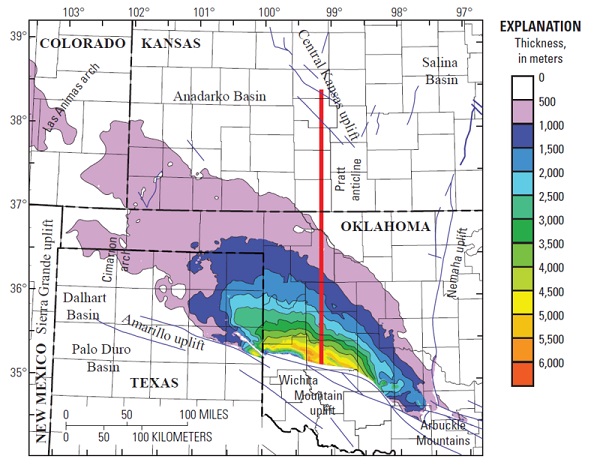
A 2014 geologic map of 50,000 square mile Anadarko Basin showing thickness of strata courtesy U.S. Geological Survey.
For 20th Century’s final quarter the Basin remains the frontier of deep drilling technology centered on Elk City, “Deep Gas Capital of the World”. As gas prices equate more closely to value, the nation’s needs may be met increasingly from this massive sedimentary basin, a focal point in drilling innovation and geological interpretation.
In re-energizing America, Anadarko will not yield its gas easily or briefly. Promised rewards lying beyond the threshold of drilling techniques demand massive investment. In challenging the inventive enterprise of America’s energy industry, this Basin will remain the heartland of technology in penetrating the earth’s crust.
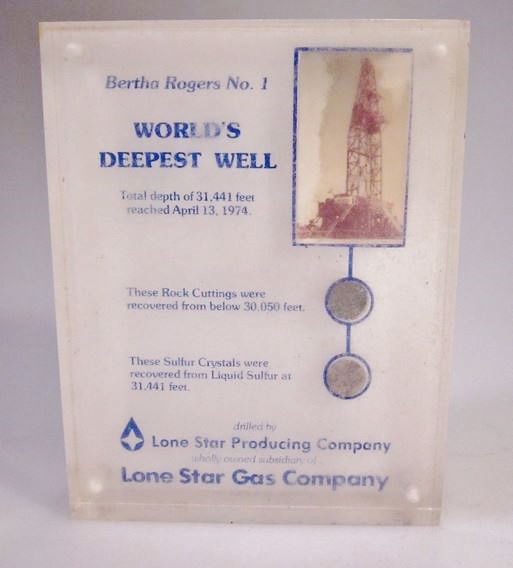
A 1974 souvenir of the Bertha Roger No. 1 well, which sought natural gas almost six miles deep in Oklahoma’s Anadarko Basin.
Until the 1960s, few companies could risk millions of dollars and push rotary rig drilling technology to reach beyond the 13,000-foot level in what geologists called “the deep gas play.”
The great expense and technological expertise necessary to complete ultra-deep natural gas wells at these depths made the Anadarko Basin “the domain of the major petroleum corporations,” explained Bobby Weaver, oil historian and frequent article contributor to the Oklahoma Historical Society.

GHK Company and partner Lone Star Producing Company believed ultra-deep wells in Oklahoma’s Anadarko Basin could produce massive amounts of natural gas. They began drilling wells more than three miles deep in the late 1960s.
South of Burns Flat in Washita County, their Bertha Rogers No.1 would reach almost six miles deep in 1974 — after a deep fishing trip.
Deep Fishing in Oklahoma
In March 1974 in far western Oklahoma, after 16-months of drilling and almost six miles deep, the Bertha Rogers No. 1 rotary rig drill stem sheared, leaving 4,111 feet of pipe and the drill bit stuck downhole. Spudded in November 1972 and averaging about 60 feet per day, the Bertha Rogers had been heading for the history books as the world’s deepest well at the time.
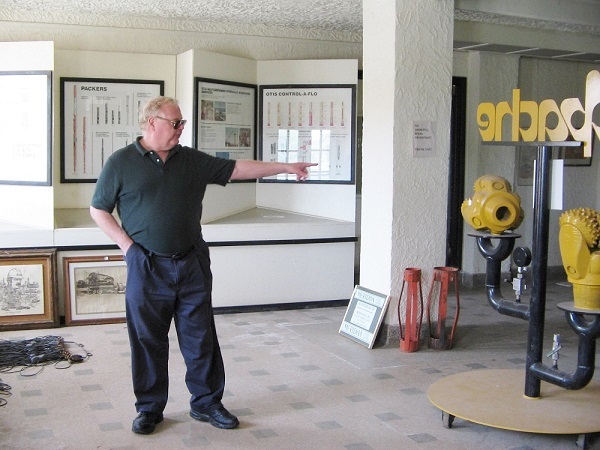
Independent producer John West in 2006 preserved artifacts in the closed Anadarko Basin Museum of Natural History in Elk City, Oklahoma. Photo by Bruce Wells.
It was March 1974 and the enormous investment of Lone Star Producing Company of Dallas, and partner GHK Company of Oklahoma City, was about to be lost. Desperate GHK executives turned to a “fishing” company in Texas.
Millions of dollars hung in the balance when Houston-based Wilson Downhole Service Company, was called and tool-fishing expert Mack Ponder sent to the rescue.
Against all odds and employing the latest 1970s technology, Ponder was able to retrieve the pipe sections and drill bit from 30,019 feet down, bringing operations back on line and enabling drilling to continue even deeper into Oklahoma’s Anadarko Basin, at a site about 12 miles west of Cordell.

Although the remarkable deep fishing achievement was celebrated, the Bertha Rogers No. 1 had to be completed at just 14,000 feet after striking molten sulfur at 31,441 feet. The equipment could not take the abuse at total depth. The well set a world record and remains one of the deepest ever drilled.
Completed at a depth of almost 25,000 feet, the Beckham County well would become Oklahoma’s deepest natural gas producer (also see Anadarko Basin in Depth`).
Fishing Tool Technician
The U.S. Labor Department describes an “Oil Well Fishing Tool Technician” (Occupational Title 930.261-010) as an occupation that “analyzes conditions of unserviceable oil or gas wells and directs use of special well-fishing tools and techniques to recover lost equipment and other obstacles from boreholes of wells,”
The government description adds that the technician plans fishing methods, selects tools, and “directs drilling crew in applying weights to drill pipes, in using special tools, in applying pressure to circulating fluid (mud), and in drilling around lodged obstacles or specified earth formations, using whipstocks and other special tools.”
_______________________
Recommended Reading: History Of Oil Well Drilling (2007); The Prize: The Epic Quest for Oil, Money & Power (1991); The Extraction State, A History of Natural Gas in America (2021). Your Amazon purchase benefits the American Oil & Gas Historical Society. As an Amazon Associate, AOGHS earns a commission from qualifying purchases.
(2007); The Prize: The Epic Quest for Oil, Money & Power (1991); The Extraction State, A History of Natural Gas in America (2021). Your Amazon purchase benefits the American Oil & Gas Historical Society. As an Amazon Associate, AOGHS earns a commission from qualifying purchases.
_______________________
The American Oil & Gas Historical Society (AOGHS) preserves U.S. petroleum history. Become an AOGHS supporting member and help maintain this energy education website and expand historical research. For more information, contact bawells@aoghs.org. Copyright © 2023 Bruce A. Wells. All rights reserved.
Citation Information – Article Title: “Fishing in Petroleum Wells.” Authors: B.A. Wells and K.L. Wells. Website Name: American Oil & Gas Historical Society. URL: https://aoghs.org/petroleum-art/high-flying-trademark. Last Updated: December 21, 2023. Original Published Date: June 1, 2006.








(2004); Plastic: The Making of a Synthetic Century
(1996); Against the Fires of Hell: The Environmental Disaster of the Gulf War
(1992); The Black Giant: A History of the East Texas Oil Field and Oil Industry Skulduggery & Trivia
(2003); Slick Policy: Environmental and Science Policy in the Aftermath of the Santa Barbara Oil Spill (2018);. Your Amazon purchase benefits the American Oil & Gas Historical Society. As an Amazon Associate, AOGHS earns a commission from qualifying purchases.










